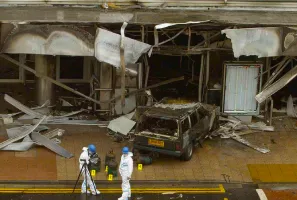Recognising Early Warning Signs
Why It Matters in the Control Room
Imagine this: you are in the control room, watching multiple CCTV feeds. Most of it is routine, staff moving around, deliveries arriving, visitors signing in. Suddenly, one feed catches your eye: a person standing too long near the fire exit, pacing, looking around nervously, and then walking away. They return an hour later and do the same thing.
At first glance, it may seem harmless. But to a trained Security Control Room (SCR) Operator, this is more than “odd behaviour,” it is a possible early warning sign. If ignored, it could lead to a break-in, insider theft, or even a serious incident.
Your role is to spot these small details before they become big problems. This is not just good practice, it is a requirement under SIA licencing standards, ACS quality frameworks, and BSI/NSI operational codes that govern evidence handling, vigilance, and risk management.
Story from the Field
A few years ago, a shopping centre in the UK experienced a series of thefts from service corridors. CCTV later revealed that, days before each theft, the same individual had been walking the corridors, checking which doors were locked, and observing staff routines.
Unfortunately, the activity had been logged as “loitering, no action taken.” Because it wasn’t escalated, the centre lost thousands of pounds in stock and faced criticism for weak security oversight.
The lesson? Early warning signs are not just red flags, they are your chance to stop incidents before they happen.
Real-World Example: The 2007 Glasgow Airport Attack
In June 2007, terrorists attempted to drive a Jeep filled with gas cylinders into Glasgow Airport’s main terminal. CCTV footage later revealed that in the weeks leading up to the attack, the suspects had made repeated visits to the site, circling the area, parking in restricted zones, and studying entry routes.
At the time, these visits were not flagged as suspicious or reported effectively. Had those observations been logged and escalated, law enforcement may have been able to intervene before the attempt.

What this teaches SCR Operators:
Multiple small incidents, when pieced together, can reveal a serious threat.
Logs are not just paperwork, they are intelligence tools.
Escalating even minor concerns is part of compliance with SIA and ACS standards, and can prevent tragedy.
Behavioural Clues to Watch For
Think of yourself as a detective in the control room. Here are some “tells” that should catch your attention:
People returning to the same spot repeatedly without reason.
Individuals closely observing CCTV cameras or entrances.
Nervous or agitated behaviour such as pacing, avoiding staff, or looking around constantly.
Overloaded bags, bulky clothing, or items being hidden.
Tip: One sign on its own may not mean much, but repeated patterns almost always deserve escalation.
Environmental Clues You Cannot Ignore
It is not always about people. Sometimes, the environment tells the story:
Fire exits blocked or propped open.
Cameras that have been tampered with or covered.
Vehicles parked too close to a restricted zone.
Alarms triggered at unusual times of day.
Scenario: During night monitoring, an operator noticed that a delivery bay door had been wedged open for “air circulation.” In reality, it became the entry point for a theft later that night.
The Psychology of Pre-Attack Behaviour
Most offenders show signs because they are anxious, testing the environment, or rehearsing. This is called “pre-attack behaviour.”
They may test how long it takes for security to respond.
They might deliberately set off a minor alarm to see what happens.
Some even engage staff in conversation to learn about procedures.
Did you know? According to UK counter-terrorism research, hostile reconnaissance is the most common activity before an attack. Spotting this behaviour early is one of the best ways to prevent incidents.
Your Role as an Early Detector
You are not just “watching screens,” you are the first line of intelligence. Police, emergency services, and your management rely on your vigilance.
Your eyes identify the clue.
Your logs create the record.
Your escalation triggers the response.
Without your awareness, small warning signs can slip through the cracks.
Example: In several foiled UK terror plots, it was not high-tech intelligence that raised alarms, it was security staff noticing repeated reconnaissance and reporting it.
Tips to Sharpen Your Detection Skills
Zoom out and zoom in: Do not stare at one camera too long. Scan widely, then focus on details.
Check context: Ask, “Does this person belong here? Does this behaviour make sense?”
Trust your gut: Instincts backed by experience are usually right, do not ignore them.
Always log, always escalate: A logged report that turns out harmless is fine. Missing a real threat is not.
Reflection Scenario
You see a person repeatedly trying the side entrance of your site over several nights. They never gain entry and leave quickly. Later, a break-in occurs at the same door.
What early signs were there?
How should you have logged this?
At what point should escalation have happened?
Did You Know?
The Home Office confirms that over 90% of criminal cases rely on CCTV evidence, which often begins with early suspicious activity.
Studies in situational awareness show that trained operators can reduce incident response times by up to 40% simply by recognising early indicators.
Final Reflection: Spotting the Signs Saves Lives
Recognising early warning signs is not paranoia, it is professionalism. Every small observation you make could be the key to preventing harm. By combining vigilance with compliance to UK security standards, you are not just monitoring, you are actively protecting lives, property, and the reputation of the security industry.

